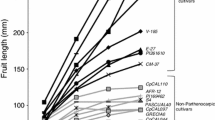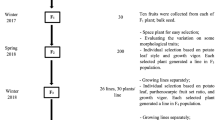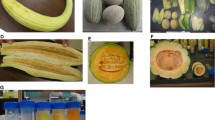Abstract
In melon (Cucumis melo L.), the amount of fertile pollen decreases at low temperature during winter and early spring and thereby restricts fertilization. A promising way to overcome this problem is to develop parthenocarpic cultivars. Parthenocarpic cucumber and squash, but not melon cultivars are available. In this study, we explored 172 accessions from an East Asian melon collection and identified accessions that exhibited strong parthenocarpic ability throughout the year. Crosses between parthenocarpic accessions and a non-parthenocarpic cultivar, and among parthenocarpic accessions indicated that parthenocarpy may be inherited in a recessive manner and is likely controlled by the same gene or genes in these accessions. The parthenocarpic indices, such as the size and number of parthenocarpic fruits, differed among the cultivation periods, indicating the importance of environmental factors for parthenocarpic fruit development. We conclude that it is possible to breed new cultivars with stable parthenocarpic ability throughout the year by using the identified accessions.





Similar content being viewed by others
References
de Ponti OMB, Garrestsen F (1976) Inheritance of parthenocarpy in pickling cucumbers (Cucumis sativus L.) and linkage with other characters. Euphytica 25:633–644
El-Shawaf IIS, Baker LR (1981) Inheritance of parthenocarpic yield in gynoecious pickling cucumber for once-over mechanical harvest by dialel analysis of six gynoecious lines. J Am Soc Hortic Sci 106:365–370
Fujishita N (2008) Melon (Part IV). Food Preserv Sci 34:103–112 (in Japanese)
Goulson D, Lye GC, Darvill B (2008) Decline and conservation of bumble bees. Annu Rev Entomol 53:191–208
Hayata Y, Niimi Y, Inoue K, Kondo S (2000) CPPU and BA, with and without pollination, affect set, growth and quality of muskmelon fruit. HortScience 35:868–870
Hayata Y, Li XX, Osajima Y (2001) Sucrose accumulation and related metabolizing enzyme activities in seeded and induced parthenocarpic muskmelons. J Am Soc Hortic Sci 126:676–680
Hayata Y, Li XX, Osajima Y (2002) Pollination and CPPU treatment increase endogenous IAA and decrease endogenous ABA in muskmelons during early development. J Am Soc Hortic Sci 127:908–911
Li D, Cuevas HE, Yang L, Li Y, Garcia-Mas J, Zalapa J, Staub JE, Luan F, Reddy U, He X, Gong Z, Weng Y (2011) Syntenic relationships between cucumber (Cucumis sativus L.) and melon (C. melo L.) chromosomes as revealed by comparative genetic mapping. BMC Genom 12:396
Lietzow CD, Zuh H, Pandey S, Havey MJ, Weng Y (2016) QTL mapping of parthenocarpic fruit set in North American processing cucumber. Theor Appl Genet 129:2387–2401
Martínez C, Manzano S, Megías Z, Garrido D, Picó B, Jamilena M (2014) Sources of parthenocarpy for Zucchini breeding: relationship with ethylene production and sensitivity. Euphytica 200:349–362
Menezes CB, Maluf WR, Azevedo SM, Faria MV, Nascimento IR, Nogueira DW, Gomes LAA, Bearzoti E (2005) Inheritance of parthenocarpy in summer squash (Cucurbita pepo L.). Genet Mol Res 4:39–46
Nogueira DW, Maluf WR, Figueira AD, Maciel GM, Gomes LAA, Benavente CAT (2011) Combining ability of summer-squash lines with different degrees of parthenocarpy and PRSV-W resistance. Genet Mol Res 34:616–623
Pike LM, Peterson CE (1969) Inheritance of parthenocarpy in the cucumber (Cucumis sativus L.). Euphytica 18:101–105
Potts SG, Biesmeijer JC, Kremen C, Nuemann P, Schweiger O, Kunin WE (2010) Global pollinator declines: trends, impacts and drivers. Trends Ecol Evol 25:345–353
Robinson RW (1993) Genetic parthenocarpy in Cucurbita pepo L. Genet Coop Rep 16:55–57
Robinson RW, Reiners S (1999) Parthenocarpy in summer squash. HortScience 34:715–717
Schneider CA, Rasband WS, Eliceiri KW (2012) NIH Image to ImageJ: 25 years of image analysis. Nat Meth 9:671–675
Sun Z, Lower RL, Staub JE (2006a) Analysis of generation means and components of variance for parthenocarpy in cucumber (Cucumis sativus L.). Plant Breed 125:277–280
Sun Z, Staub JE, Chung SM, Lower RL (2006b) Identification and comparative analysis of quantitative trait loci associated with parthenocarpy in processing cucumber. Plant Breed 125:281–287
van Engelsdorp D, Evans JD, Saegerman C, Mullin C, Haubruge E, Nguyen BK, Frazier M, Frazier J, Cox-Foster D, Chen Y, Underwood R, Tarpy DR, Pettis JS (2009) Colony collapse disorder: a descriptive study. PLoS ONE 4:e6481
Winfree R (2010) The conservation and restoration of wild bees. Ann NY Acad Sci 1195:169–197
Wu Z, Zhang T, Li L, Xu J, Qin X, Zhang T, Cui L, Lou Q, Li J, Chen J (2016) Identification of a stable major-effect QTL (Parth 2.1) controlling parthenocarpy in cucumber and associated candidate gene analysis via whole genome re-sequencing. BMC Plant Biol 16:182
Acknowledgements
We thank N. Fujishita and H. Furukawa at Osaka Prefecture University for providing critical comments on this research. We also thank F. Hori, S. Masuji, M. Shindo, M. Wakabayashi, Y. Taki, A. Suzuki, and C. Yamada of the Institute of Vegetable and Floriculture Science, NARO, and K. Moriyama, H. Matsumura, N. Nishi, and T. Iwaya of the University of Tsukuba for technical assistance. This work was supported by Japan Society for the Promotion of Science (JSPS) KAKENHI (Grant Nos. 23780034 and 26712004).
Author information
Authors and Affiliations
Corresponding author
Ethics declarations
Conflict of interest
The authors declare that they have no conflict of interest.
Electronic supplementary material
Below is the link to the electronic supplementary material.
Rights and permissions
About this article
Cite this article
Yoshioka, Y., Shimomura, K. & Sugiyama, M. Exploring an East Asian melon (Cucumis melo L.) collection for parthenocarpic ability. Genet Resour Crop Evol 65, 91–101 (2018). https://doi.org/10.1007/s10722-017-0511-7
Received:
Accepted:
Published:
Issue Date:
DOI: https://doi.org/10.1007/s10722-017-0511-7




